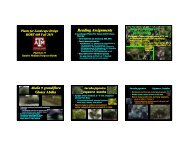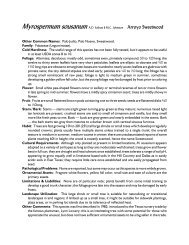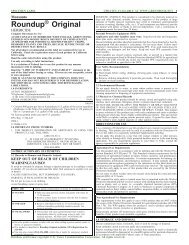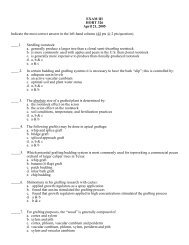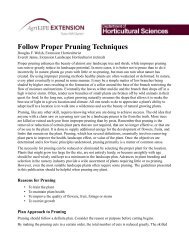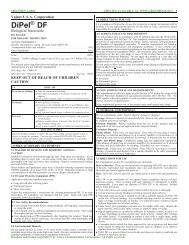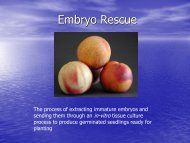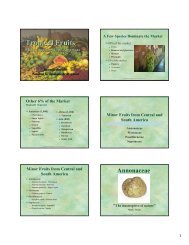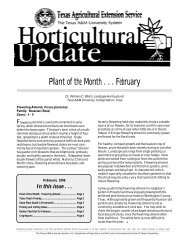Processing Acid and Acidified Foods - Aggie Horticulture
Processing Acid and Acidified Foods - Aggie Horticulture
Processing Acid and Acidified Foods - Aggie Horticulture
Create successful ePaper yourself
Turn your PDF publications into a flip-book with our unique Google optimized e-Paper software.
ACIDIFIED FOODS<strong>Processing</strong> <strong>Acid</strong> <strong>and</strong> <strong>Acid</strong>ified <strong>Foods</strong>FBNS 10-0101ACIDITY AND pHFood scientists measure the acidity of a food based on itspH value. The pH scale ranges from 0 to 14 with pH 7being neutral. The lower the pH value, the higher the levelof acidity. In order to preserve foods with acid, theregulations require the equilibrium pH of the finishedproduct to be 4.6 or below. At these levels, toxins formedby the deadly organism causing botulism are inhibited.Because all products <strong>and</strong> processes exhibit normalvariation, the pH must be measured using a pH meter. Forproducts with a pH below 4.0, pH test strips may be usedfor monitoring purposes. Records of pH monitoring must bemaintained for all products classified as acid or acidified.CLASSIFICATIONWe refer to foods with a pH greater than 4.6 as low-acidfoods. For foods with a pH below 4.6 that are preservedwith acid, there are two classifications. The distinctionbetween these two categories is important.<strong>Acid</strong> <strong>Foods</strong>: <strong>Foods</strong>, such as tomatoes, which have a naturalpH of 4.6 or below are considered to be acid foods. Somefoods which contain small amounts of low-acid foods in apredominantly acid food, such as herbal vinegars, are alsoin this category. If the finished equilibrium pH does notvary significantly from the pH of the predominant acidfoods, the food is considered to be an acid food.<strong>Acid</strong>ified foods are low-acid foods to which acids or acidfoods have been added to produce a pH of 4.6 or below. TheFood <strong>and</strong> Drug Administration (FDA) has additionalrequirements for the processing of acidified foods. These canbe found in the Code of Federal Regulations (21CFR114). Inthe absence of information to the contrary, foods preservedwith acid are considered to be acidified foods.The manufacturer of acidified foods must register theirestablishment <strong>and</strong> file a scheduled process established bya competent process authority. In addition, the operationmust be under the supervision of an individual who hassuccessfully completed an FDA approved course onprocessing acidified foods. The regulation addresses otherimportant aspects of manufacturing such as monitoring <strong>and</strong>record keeping. These regulations do not apply to naturallyfermented foods or jams, jellies <strong>and</strong> carbonated beverages.Visit online: Instructions for Establishment Registration <strong>and</strong><strong>Processing</strong> Filing for <strong>Acid</strong>ified <strong>Foods</strong>.CONTROLLING SPOILAGELow pH cannot take the place of proper sanitation <strong>and</strong> carein manufacturing. Good Manufacturing Practices (GMPs)were designed <strong>and</strong> instituted by the federal government toassure that foods are manufactured <strong>and</strong> h<strong>and</strong>led in a safe<strong>and</strong> sanitary manner to prevent adulteration. The conditionsset forth in the regulation (21CFR110) must be met tooperate your business.Typically acid <strong>and</strong> acidified foods are heat treated in one oftwo ways:1. Hot fill <strong>and</strong> hold - The product is filled at atemperature of 180°F or above <strong>and</strong> the heated closureis applied by a steam capper or alternately, the closedcontainer is inverted. The increased temperature abovethe minimum process temperature is necessary to heatthe container <strong>and</strong> closure to destroy themicroorganisms on inside surfaces.2. Water bath or steam process - The preheatedproduct is filled into the container <strong>and</strong> the closure isapplied. The container is subjected to hot water <strong>and</strong>steam until the coldest spot in the container reaches theminimum process temperature. The minimum processtemperature typically used is 165°F for 15 seconds orthe equivalent.Post processing contamination <strong>and</strong> preservativesThe thermal process destroys vegetative cells in the product<strong>and</strong> the hermetic seal protects the product fromrecontamination while it is intact. Once the seal integrity iscompromised by leakage, lack of vacuum, or simply by theconsumer opening the container, microorganisms mayreenter the product <strong>and</strong> cause contamination. For thisreason, preservatives should be used in acid <strong>and</strong> acidifiedfoods, especially when the consumer is likely to open <strong>and</strong>re-close the container. Sodium benzoate <strong>and</strong> potassiumsorbate are often chosen for this purpose. They are typicallyused together at a rate of 0.1% each by weight, to take
FBNS Fact Sheet 2advantage of their combined effects. They are especiallyeffective against yeasts <strong>and</strong> molds.PLASTIC CONTAINERS AND PRODUCTS WHICHCAN NOT BE HEATEDMost plastic containers will not withst<strong>and</strong> the hightemperatures of “hot fill <strong>and</strong> hold” or “water bath”processes. However, under certain conditions, alternativeprocessing can be used for acid or acidified foods. If theproduct is classified as an acidified food, a processauthority would need to approve any alternative processingmethods.1. First - Destroy the vegetative cells in the producta). At low pH, pathogens may not grow, but they canstill survive <strong>and</strong> cause foodborne illness. One methodof destroying these cells would be to heat the productto180°F or above, then be cooled sufficiently prior tofilling plastic containers.b). If the product does not allow for a heat treatment,an alternative process would be to adjust the pH tobelow 3.3, prior to filling. When a product with a pHthis low is stored for 24 hours at 75°F, research showsthat the vegetative cells of common foodbornepathogens are destroyed.An adequate sanitation program should be in place <strong>and</strong>documented to ensure that containers <strong>and</strong> the processingenvironment will not contribute to the contamination of theproduct.2. Second - Prevent the growth of other organisms,specifically yeasts <strong>and</strong> moldsa). Use preservatives such as sodium benzoate <strong>and</strong>potassium sorbate to prevent the growth of yeast,molds <strong>and</strong> other organisms. Certain microorganismsthat re-contaminate the product from the environmentmay grow in the product <strong>and</strong> cause spoilage. Oneconcern is that molds might actually grow <strong>and</strong>consume acids, thereby increasing the pHCHALLENGE STUDIESThere is a possibility that some products contain inhibitoryproperties that will prevent the growth of microorganismsof public health significance without using the st<strong>and</strong>ardtreatments mentioned above.The “Hurdle Concept”The “hurdle concept” refers to the combined effect ofvarious factors such as salt, water activity, pH <strong>and</strong>temperature on the inhibition of bacterial growth. Thistechnique is often used by larger food companies who areable to exert high levels of technical control over theprocess <strong>and</strong> the product. Challenge studies would be neededto validate the use of this method. These studies areexpensive <strong>and</strong> time-consuming. They require very carefuldesign to validate safety. Anyone who wishes to pursue thehurdle concept <strong>and</strong> challenge studies is directed to privateoutside laboratories.LABELING THE FOODRegulations dealing with the food label are extensive <strong>and</strong>complicated. Before purchasing any labels, it would be wiseto consult with regulatory authorities. The North CarolinaDepartment of Agriculture <strong>and</strong> Consumer Services,NCDA&CS (919-733-7366) will review your label forcompliance at no charge. The FDA also has an excellentresource: Food Labeling GuideOTHER RESOURCESThe Code of Federal Regulations (CFR), referenced above,is the published rules of the federal government. It isdivided into 50 chapters. Chapter 21 deals with food <strong>and</strong>drugs. The searchable documents can be accessed online at:Code of Federal Regulations<strong>Acid</strong> <strong>and</strong> acidified foods are regulated by the NCDA&CS,phone 919-733-7366. Contact them for the appropriateregulatory guidance concerning facility inspection, GMPs(Good Manufacturing Practices) <strong>and</strong> labeling.In addition to the establishment registration for thosefacilities processing acidified foods, all facilities thatmanufacture, process, pack, or hold food for human oranimal consumption in the United States must register withthe FDA under the Bioterrorism Act. There is no fee <strong>and</strong>registration can be completed on-line at:Food Facility RegistrationDr. John Rushing <strong>and</strong> JoAnna FoegedingNorth Carolina State University College of Agriculture <strong>and</strong> Life SciencesDepartment of Food, Bioprocessing <strong>and</strong> Nutrition SciencesCampus Box 7624 Raleigh, NC 27695-7624919.515.2956 fax 919.515.7124 www.ncsu.edu/foodscience/extension_program




